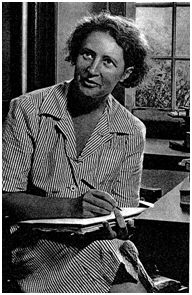
AnthonyFlood.com
Panentheism. Revisionism. Anarchocapitalism.

Peg Brand, "Susanne Katherina Knauth Langer" Rout-ledge Encyclopedia of Philosophy. London, 1998.
Susanne K. Langer
1895-1985
With roots in logic, philosophy of language and philosophy of mind, Susanne Langer sought to explicate the meaning and cognitive import of art works by developing a theory of symbolism that located works of art at the centre of a network of relations based firmly on semantic theory. Art works were nondiscursive, presentational symbols that expressed an artist’s ‘life of feeling’, by which observers, through a process of immediate apprehension (or intuition) came to acquire knowledge.
Langer was educated at Radcliffe College and briefly attended the University of Vienna. She held the post of tutor at Radcliffe from 1927 to 1942, followed by positions at the University of Delaware (1943), Columbia University (1945–50), the Connecticut College for Women (1954–62), and a number of visiting positions.
Langer’s early writings prefigure her later theorizing on art. The Practice of Philosophy was influenced by work on symbolism by Whitehead and the early Wittgenstein. For Langer, the relation between a symbol and the symbolized object depended solely upon analogy of form; only by studying the structure of an entity and its comparable analogue could the symbolic relationship be established. The logical analysis of symbols—as analogues to one’s concrete experiences—admitted of meanings that were incommunicable by ordinary, public discourse. Symbols, through nondiscursive form, achieved cognitive weight and force equal to the original experience. As such, they transmitted knowledge of the ineffable. Her second text, An Introduction to Symbolic Logic, moved beyond a presentation of standard techniques in symbolic logic to an exploration of its conceptual foundations.
Her explicit theory of art began with Philosophy in a New Key: A Study in the Symbolism of Reason, Rite and Art. Combining her interest in the nature of knowledge with a longstanding wish to actualize a complete theory of mind (realized decades later with the publication of Mind: An Essay on Human Feeling), she expanded her discussion of symbols by focusing on the role of human reason in ritual acts and the creation of art objects. Challenging traditional philosophical approaches, which had previously located the focus of attention in theories of taste, beauty or notions of aesthetic value, she sought to alter radically the most basic questions in the philosophy of art. Symbolism was the ‘new key’ to understanding how the human mind transformed the primal need to express oneself. All forms of human activity, including ‘speech and gesture, song and sacrifice’ were seen as expressive. The mental work of symbolic transformation resided in abstracting a gesture or an object from reality. Symbols, in contrast to signs (later called signals), gave expression to thoughts that went beyond what could be expressed in language. Therefore, a wide range of symbols evolved over time: simple ones became complex; ritual (or convention) became art. Art became the conveyor of inner life: artists expressed ‘ideas of feeling’—‘formulation and representation of emotions, moods, mental tensions and resolutions’—not their own actual or personal feelings. The artistic significance of music, for instance, consisted in pure form—‘the sensuous percept’—apart from its literal content (what, if anything, it represented).
In Feeling and Form, written eleven years later as a sequel to Philosophy in a New Key, art was characterized as the creation of forms symbolic of human feeling. Every work of art involved (1) abstraction from actuality, thereby becoming mere semblance, a created realm of illusion, (2) plasticity (the capacity of being manipulated in the interests of expression), and (3) expressiveness whereby the symbol became transparent. A focus on the meaning of art works was replaced by a discussion of their import or significance. Intuition became the link between the qualities of the art work that constituted it a symbol and the import the work of art held for the observer. Through intuition, we perceive the ‘felt life’ of the artist’s expression.
In Problems of Art, a collection of essays originally delivered as lectures, Langer refined her views: a work of art was a form expressive of human feeling, created for our aesthetic perception through sense or imagination. Emphasizing the role that artistic intention played in creative activity, she traced the unity of the arts to their semblance of organic form. Insight (understanding of the essential life of feeling) was designated the aim of art. Reflections on Art, a collection of twenty-six essays ranging over music, art, dance, poetry, film and architecture, focused on two main issues: expressiveness and semblance. Her list of contributors included artists and ‘lay aestheticians’, as well as professional philosophers. Her final work, Mind, ambitiously sought to explicate the role feelings play as the mind functions uniquely in humans, and in particular how an artist projects an idea of feeling by means of art.
Langer main page